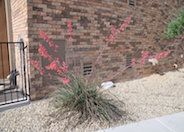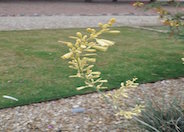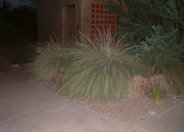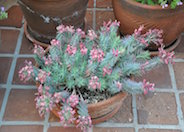
Common name:Bi-colored Hesperaloe
Botanical name:Hesperaloe parviflora 'Duet'
Spectacular accent for desert gardens anywhere. Plants tolerate drought, full sun, reflected heat, and poor soils. Forms rosettes of leaves 4' x 6'. The red and yellow flower stalks emerge in spring and remain on the plant until the end of summer. - Mountain States Nursery

Common name:Gold Mound Lantana
Botanical name:Lantana 'Gold Mound'
This mounding groundcover can reach 3' tall and has small, leathery green leaves with very round golden yellow flowers. Attracts butterflies.

Common name:Hesperaloe Yellow
Botanical name:Hesperaloe parviflora 'Yellow'
Upright succulent grows quickly to 3' x 5'. The yellow flower stalks emerge in spring and remain on the plant until the end of summer. Dark green strappy leaves. Plants tolerate drought, full sun, reflected heat, poor soils, and frost.

Common name:Bamboo Muhly
Botanical name:Muhlenbergia dumosa
Clumping grass grows at a moderate rate to 4' x 4'. Leaves are bright green and turn tan in fall. Flowering plumes appear fall, they start our green and dry to tan. Resembles short bamboo. Great in containers. Creates soft billowy effect in landscape. Accepts full sun or partial shade. Prune in spring when it begins growing & divide every 3-4 years. Native to Arizona and northwest Mexico.

Common name:Capital Columnar Callery Pear
Botanical name:Pyrus calleryana 'Capital'
The 'Capital' assumes a hardy, columnar form with thick, glossy green leaves that change from a red to a purple color in the fall. White flowers are borne in the spring. It reaches a size of 30' high by 7'-8' wide, and is a good tree where space is limited.

Common name:Donkey Tail Euphorbia
Botanical name:Euphorbia myrsinites
This hardy perennial grows 4-6" and has blue glaucous leaves that are stiff and round, set closely to the stem. Flattish clusters of chartreuse to yellow flowers bloom between late winter and early spring.
| Designer: Jennifer Barr | Barr Gardens 6 |
Photographer: GardenSoft |
Soils and Compost:
Incorporate compost 6" into your soil to retain water, reduce compaction, feed earthworms, and provide valuable nutrients to your plants.
Water Saving Tip:
Apply a layer of mulch around plants to reduce moisture loss.
Choose organic mulches, such as shredded bark, compost or aged sawdust.
Integrated Pest Management:
Drip and other smart irrigation delivers water directly to roots, allowing no excess water for weeds.
